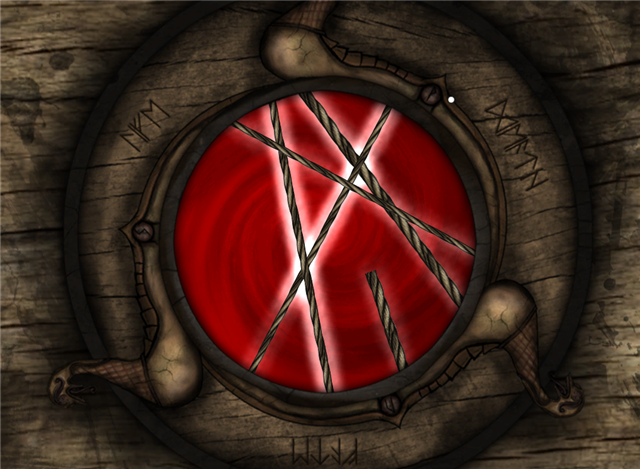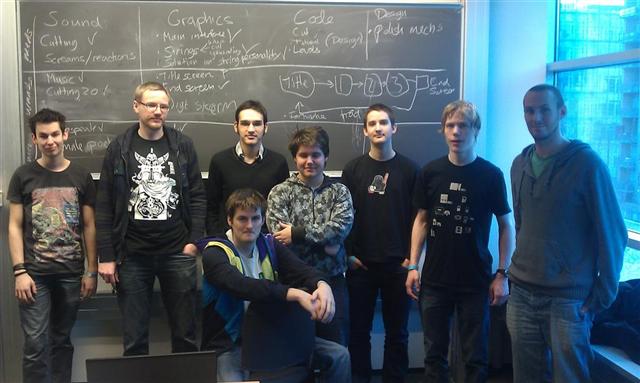Strings of Fate
Project type: Nordic Game Jam
Made: January 2011
My fields: Game design, Scripting
Time spent on this project: 48 hours
Tools used: Unity 3.1, PhotoShop CS5, Visual Studio Express 2010, GarageBand
DOWNLOAD:
Strings of Fate
About this project:
The only thing you can do is hurt people. Your goal is to hurt as few as possible.
Strings of Fate is a game made by a team of eight people during the Nordic Game Jam 2011, which is a part of the international Global Game Jam. The game was built in Unity 3.1, using C# and JavaScript as the scripting languages. I was behind most of the initial game design, as well as coding some parts of the game.
The core game concept
The theme for this year’s Global Game Jam was “extinction”. We would like to do something different by focusing more on the theme and feel of the game instead of the actual mechanics. We wanted to make an abstract game with an implicit narrative style, using visual and auditory cues to suggesting the underlining theme.
The actual gameplay is very simple: You cut strings that are gradually moving around the screen. Most of the strings are “innocent”, while others are “evil”. These infected strings will kill other strings when touched. Your goal is to find the bad strings and cut them, but it is not always easy to distinguish between the two types. Every time you cut an innocent string, a horrible scream is played, indicating the seriousness of your actions.
So … an art game about Fate and Norse Mythology?
We knew it was going to be a tough task, but we wanted to challenge ourselves. Our idea was to make a very abstract game that didn’t tell a particular story, but instead implicitly give hints about different kinds of emotion.
In our first brainstorm sessions we thought about making a “save-the-world” God style of game. It seemed a bit obvious, so we decided continuing brainstorming. At some point one of the designers and myself began talking about destiny, and the concept of a self-fulfilling prophecy. Somehow I got an image in my head of the three old ladies from the Disney adaption of the Greek half-god Hercules. The ladies are called The Fates, and their task is to cut life strings, and thus decide when people are going to die.
Our initial idea was to have an abstract representation of human lives as small and fragile strings. Like in a cobweb, they are all interrelated and connected to each other. But we didn’t want to tell directly that these strings were supposed to be human life lines. Instead we used visual and auditory cues, as well as small paragraphs of poems suggesting what the player is supposed to do.
Since the theme was “extinction”, we chose a rather grim approach to the game’s design: There is no right or wrong action in the game. Instead, all of your actions are wrong by default, i.e. you are killing people by cutting their life strings. The only thing you can do is minimizing the amount of lost innocent lives by finding the “evil strings” as quick as possible. The evil strings are infected and kill other strings; their reason for doing so is unknown and up to the player to guess why.
The cutting mechanic
Following the theme of uncertainty, we wanted the cutting mechanic being not too easy to control. Instead of simply clicking on each string, we decided to use a more “cut/slash” style of input where you have to keep holding down the mouse button. Because of this, it is sometimes hard to pinpoint one single string and cut it, and thereby you often end up cutting more strings than you wanted to. You can’t make high-precision cuts which means that you are responsible for taking away a good amount of innocent lives, even if it wasn’t your intention to do so.
Working with an abstract game design
The game is very minimalistic and abstract in nature, and we wanted it to be as less “game-y” as we could make it. We chose not to have levels, high scores or tutorials, and neither is there a Game Over screen at the end like you would normally expect. In fact, you can’t really “win” this game, and no matter what you do people are going to die.
In the beginning we aimed for making it 100% text-less, only using sound and images. However, we learned that it was simply too hard for players to grasp the concept of our game. Therefore we decided to make the visuals less abstract, which resulted in having a theme based on the Norse Mythology. Previously we were thinking about Greek Mythology, but when we discovered that a similar concept of three women representing Fate is used in Scandinavia as well, we settled on this theme instead. We also wrote some small poems that we placed in between the transitions setting the overall tone of the game.
Not a game – an experience
Like many other “art games” Strings of Fate isn’t so much about the game mechanics, but rather the player’s holistic experience of the whole package. Our goal was for the player to play the game and experience the grim nature of Fate. Each scream and cry should hit you and make you wonder: “What have I actually done? What am I killing … and why?” Like all great works of art, you as a person have to connect the dots and interpret the underlining system: To feel something deeper than just a game about killing this or that.
Whether we succeed with our vision is hard to say. Maybe the game concept is too difficult to understand and the mechanics too simple. It is indeed not a very conventional game. It requires a lot of patience from the player, while questioning the tropes of killing in videogames. Normally you want to kill anything moving as fast as possible. You can do that in Strings of Fate if you want, but you may also pause for a second and think about your actions.
In the end we all learned a lot about using abstract concepts in games. Clear communication to the player is important, and good feedback mechanisms are key to success.

Credits
Benjamin Overgaard
Dennis Lauersen
Gustav Dahl
Kristian Klie
Magnus Lund
Lasse B. Hansen
Thomas Pilgaard
Xavier Lafont







[…] Se en af spilskabernes egen forklaring på spillet her […]